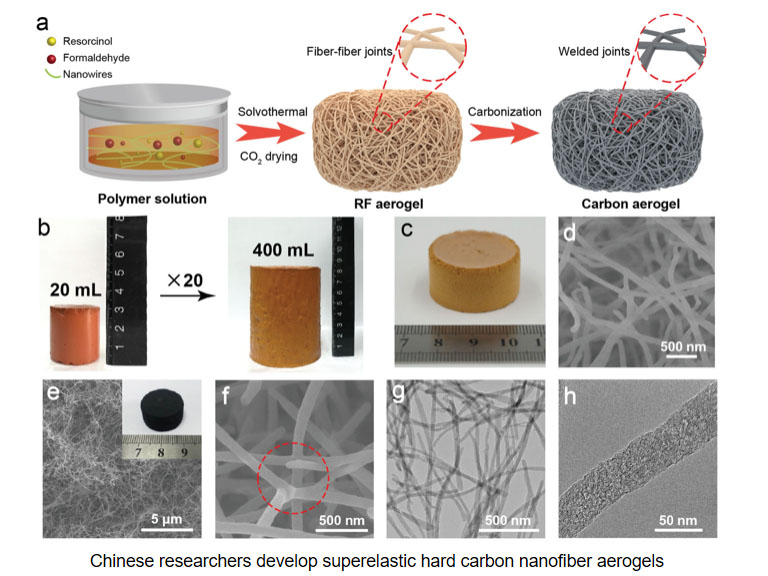Ka lebaka la ho susumetsoa ke ho tenyetseha le ho tiea ha tepo ea silika ea sekho, sehlopha sa bafuputsi se etelletsoeng pele ke Prof. YU Shuhong oa Univesithi ea Saense le Theknoloji ea Chaena (USTC) se ile sa hlahisa mokhoa o bonolo le o akaretsang oa ho etsa li-aerogels tse thata tsa carbon tse thata tse nang le nanofibrous, tse khonang ho thibela mokhathala. mohaho oa marang-rang ka ho sebelisa resorcinol-formaldehyde resin e le mohloli o thata oa carbon.

In recent decades, carbon aerogels have been widely explored by using graphitic carbons and soft carbons, which show advantages in superelasticity. These elastic aerogels usually have delicate microstructures with good fatigue resistance but ultralow strength. Hard carbons show great advantages in mechanical strength and structural stability due to the sp3 C-induced turbostratic “house-of-cards” structure. However, the stiffness and fragility clearly get in the way of achieving superelasticity with hard carbons. Up to now, it is still a challenge to fabricate superelastic hard carbon-based aerogels.
Polymerization ea li-monomers tsa resin e qalile ka pel'a nanofibers e le litempele tsa meralo ea ho lokisa hydrogel e nang le marang-rang a nanofibrous, e lateloa ke ho omisa le pyrolysis ho fumana hard carbon aerogel. Nakong ea polymerization, li-monomers li kenya litempeleng ebe li cheselletsa manonyeletso a fiber-fiber, e siea sebopeho sa marang-rang se nang le manonyeletso a maholo a matla. Ho feta moo, thepa ea 'mele (joalo ka bophara ba nanofiber, density ea li-aerogels, le thepa ea mochini) e ka laoloa ka ho lokisa litempele le palo ea lisebelisoa tse tala.
Ka lebaka la li-nanofiber tsa carbon tse thata le manonyeletso a mangata a cheselitsoeng har'a li-nanofibers, li-aerogels tsa carbon tse thata li bonts'a ts'ebetso e matla le e tsitsitseng ea mochine, ho kenyelletsa le super-elasticity, matla a phahameng, lebelo la ho hlaphoheloa ka potlako (860 mm s-1) le coefficient e tlase ea tahlehelo ea matla ( <0.16). Kamora ho lekoa tlas'a khatello ea 50% bakeng sa lipotoloho tse 104, carbon airgel e bonts'a 2% feela ea ho senyeha ha polasetiki, 'me e bolokile khatello ea maikutlo ea 93%.
The hard carbon airgel ka boloka super-elasticity maemong a thata, joalo ka mokelikeli nitrogen. E ipapisitse le thepa e khahlang ea mochini, airgel ena e thata ea carbon e na le ts'episo ts'ebelisong ea li-sensor tsa khatello ea maikutlo tse nang le botsitso bo phahameng le mefuta e mengata ea lipatlisiso (50 KPa), hammoho le li-conductors tse otlollang kapa tse kobehang. Mokhoa ona o na le ts'episo ea ho atolosoa ho etsa li-nanofiber tse ling tse se nang k'habone mme e fana ka mokhoa o ts'episang oa ho fetola lisebelisoa tse thata hore e be lisebelisoa tse otlolohileng kapa tse tenyetsehang ka ho rala li-microstructures tsa nanofibrous.
Post time: Mar-13-2020























































































































